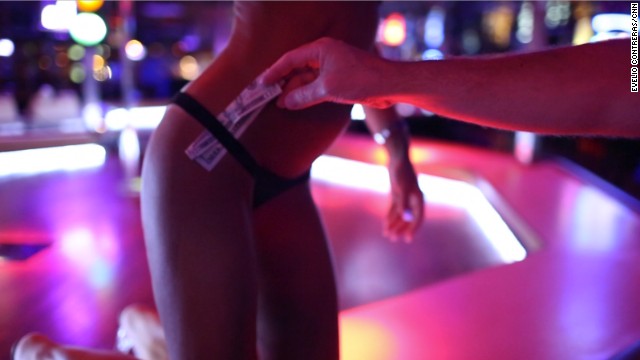Everything is dark walking inside from the street, straining the eyes. The music is loud rock with a throbbing bass.
Slowly, the eyes adjust to see red walls, leather chairs and couches, a bit of fluorescence on the walls.
Then, into the main room, in the bright light from above, a blond woman is dancing to the rhythm on a raised stage, naked save for a minuscule bit of lingerie, sinuous as a Slinky.
Welcome to Rick’s Cabaret in Herald Square, one of Manhattan’s elite gentlemen’s clubs, upscale from top to bottom; from the Kobe beef burgers to the flat-screen TVs, lobster and bottles of Scotch.
This is the province of high rollers, a place where suits with expense accounts, rap stars and athletes such as Alex Rodriguez throw their money around – sometimes quite literally.
High-end strip clubs offer prewrapped bundles of various denominations of cash, generally in $1,000 packets, for those who want to buy tips for the dancers and others who want to throw cash up in the air on the dance floor for anyone who grabs it.
Rap stars and athletes popularized the custom, called “making rain.”
And then there are the women, “the product,” as club entrepreneurs call them, the main attraction, often supernaturally attractive, available near-naked for a lap dance or conversation at rates that range from $20 for two minutes to $400 an hour.
“One customer, a widower, spends $50,000 here a month, and no I won’t tell you his name,” said Eric Langan, the CEO of Rick’s. “His wife died, he comes here, he feels he’s the king. The loneliness is gone.”
“He always takes a VIP room,” said Langan, referring to the secluded, curtained-off rooms on the third floor slated for more private entertainment and gatherings, including bachelor parties.
There is no sexual contact with customers, management explains, no prostitution, no seediness like in the old-time strip clubs, and no organized crime hooks.
Today, gentlemen’s clubs in the city, and across the nation, are becoming big business and quite conventionally corporate. With profit margins up to 30% they can rake in hundreds of millions of dollars.
Rick’s is part of a publicly traded corporation, Rick’s Cabaret International Inc., with shares traded on the NASDAQ, and accountants, attorneys, Securities and Exchange Commission filings and a business model not very much different than WalMart, except for what’s being sold.

“For guys, it’s male bonding, or an escape from reality,” Langan said. “You want to believe this 19-year-old girl really loves you, is listening to you and maybe in another time, she could be your girlfriend. So you can spend $3,000 here and say ‘Hey, I had a good time.’
“We want you to come back. We want your money every week,” he said.
Rick’s owns, operates or licenses, 14 adult entertainment clubs around the country, including venues in Houston, Minneapolis and New Orleans.
Another such company, VCG Holding Corp., publicly traded on the American Stock Exchange, owns eight clubs around the country and manages another five – none in New York.
The stock price of both – the only two publicly traded companies of their kind – have shot up remarkably over the last year or so. VCG, headquartered in Denver, is up 700% from its low and Rick’s, headquartered in Houston, has climbed 100% from its 52-week low.
Because they are publicly traded, unlike Scores and the city’s other upscale gentlemen’s clubs, Rick’s and VCG must disclose detailed balance sheets: profits, losses, costs and investments.
Those financials provide a unique look at the unusual economics of the modern strip clubs and the millions of dollars they generate.
One factor boosting the bottom line is that unlike other businesses, there is no cost for the key labor force, the strippers. Quite the opposite, for the dancers pay the clubs for the right to work.

The fee at Rick’s is $100 a night, and in return, the women keep all the money they receive from customers, including credit-card charges. At Scores, better known and somewhat more luxurious, the dancers pay the club $300 a night to work.
“They’re independent contractors,” Langan said. “We provide a safe and secure place for them to earn their money.”
He and Troy Lowrie, CEO of VCG Holdings, explained that the practice is accepted nationwide, and that dancers’ fees account for about 10% of revenues in their business model.
The dancers say the fees, called “house charges,” are a small price to pay when they consider their income.
Jasmine, a lissome blond dancer at Rick’s, said, “It works out well. I have a masters in psychology from LIU [Long Island University] and I need to pay off my school loans. Where else could I make $600 a day or more?”
The other major revenue items are cover charges, food and alcoholic beverages, which provide the bulk of revenue.
“Revenues at Rick’s in New York were up 63% in the first quarter,” said Langan, 39. He got into the business at 20, in Dallas, buying his first club with the proceeds of his rare baseball card collection.
“It’s all about the numbers,” he said, quickly ticking off a few. The rent at the 10,000-square-foot club is $49,000 a month, he said, and gross profit margin on total revenues is about 35%.
Nothing is left to chance: To avoid day-after disputes with customers who decide they’ve spent too much, big-spending customers are fingerprinted, and sign separate approval forms for credit charges. Credit-card companies are telephoned in advance for approval on spending limits.
And business is booming.
“The top 30 clubs in the country are valued between $700 million and $1 billion,” Langan said. “There’s a lot of consolidation going on and we are expanding. I’d love to buy another club in New York.”
Lowrie has similar ambitions. “Our guidance shows us buying two more clubs this year and five more clubs next year because with our stock price, we can raise money and we have a pipeline full of potential acquisitions.”
There are about 3,600 strip clubs nationwide, Lowrie said. “And from a business point of view, it’s all like Las Vegas was in the early ’70s. Investors and banks are realizing that like gambling and casinos, adult entertainment and gentlemen’s clubs are a legitimate business.”
“There’s nothing we don’t take into account,” Langan said. “Club location, nearest competition, the legal environment in a city and zoning laws when we invest.
“Ultimately though,” he added, “you want to get into a market and dominate, just like any other business.”

